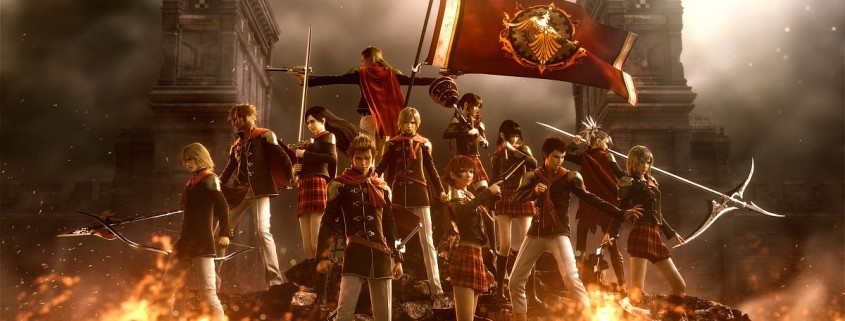SCA hosts Square Enix’s Kazuyuki Ikumori
On Thursday night, the USC School of Cinematic Arts hosted gaming giant Square Enix’s Visual Works CG Studio General Manager and Chief Creative Director Kazuyuki Ikumori, who’s contributed to the company’s fame with his work on the Final Fantasy, Tomb Raider, Hitman and Deus Ex titles. Square Enix began its special college tour in late February starting with Southern Methodist University. The Japanese video game developer is holding these special lectures as an opportunity for students to learn about the company’s creative development from one of the top members of the Square Enix team. (And no, there was no announcement of a Final Fantasy VII remake.)
The USC game development program is a collaboration between the School of Cinematic Arts’ Interactive Media and Games Division and the Viterbi School of Engineering’s Department of Computer Science. In 2014, the Princeton Review recognized USC as North America’s top-ranking institution in both undergraduate and graduate studies for game design. “The reason we choose [USC] was because of the reputation of the university as well as the talent that is being developed here,” said David Yang, director of public relations at Square Enix. “We wanted to bring our leaders, in the game development and computer animation industry, to share some of the professional and life lessons that they’ve gathered over their careers and pass that knowledge on to the next generation of game developers.”
Hosted by professor Danny Bilson, and with live translations by Square Enix localization specialist and USC alumnus Elijah Smolko, the 2-hour lecture gave Trojans a look into the work that goes into Square Enix’s games. Ikumori is a veteran and a major player in the cinematic movie production portion of Square Enix’s portfolio. Ikumori’s presentation went into painstaking detail about the entire process of CG animation, delighting some students and worrying others. Students were shocked by exactly how much work the company puts into just modeling one character. The entirety of the lecture will be uploaded to the Square Enix Presents Twitch channel for those who could not come into the lecture in .
The lecture gave students a unique opportunity to listen to and absorb the processes down to the smallest details, covering such topics as props and background design. From the breakdown of the management board to the techniques behind Square Enix’s renowned CG modeling, the lecture provided an unfiltered look into just one part of the game development process. Ikumori revealed a list of more than 30 different programs that Square Enix uses for the creation of its visuals. He explained that if there is no program on the market for what they need, the company would make its own tools, exemplifying the company’s commitment to continual innovation.
“Quality control is the biggest challenge with games. Especially with games, the game engine and their specs tend to be a little bit lower than, say, the CG engines that we use,” Ikumori said, through Smolko’s translation. “Whereas with the game engines, you’ll get one release then it’ll be years before you see any increase in specs or resource processing. Whereas with CG tools and engines, you’re seeing updates almost every year. Sometimes the game engine can’t meet up to it.” Ikumori went on to explain that the visual team often has to lower quality in order to show their visuals on the current generation of game consoles.
Indeed, Square Enix makes the cinematography and CG visuals look so easy and flawless, but there is an unseen world of hard work. According to Ikumori, for a large team to come together and work on a project, there will surely be heated arguments. To make the process more streamlined and easier to understand, Square Enix follows a certain strategy, one part of which is that after finalizing the concept, the next step is pre-visualization, or pre-vis. This is when a clear image is created in which anyone can understand what needs to be portrayed regardless of what stage the image is on. For example, while someone can get a grasp of the general subject in the picture, there’s no real idea of where the camera angle or lighting will be. Sometimes assets from previous, older games may be used even if they stand out, just to clarify that visualization.
Recently, there has been concern over the lack of artistic flow in the gaming industry. Students are worried that their creativity might not have the chance to flourish.
“It really depends on the style and culture of a development team or company. Our Tokyo office is pretty free,” Ikumori said. “Especially for creators, you can make changes and updates at almost up to the last minute. For a scheduling deadline, it can be a big headache, but in terms of a creative aspect its great with the amount of freedom there is.”
Ikumori ended the talk by inspiring the audience with words of encouragement. “What I really want to get across is for each of you to create your own original vision and cultivate it. By that, what I mean is to have a strong idea of what you want to create but do not become overconfident to get to a point where you’re confining yourself,” Ikumori said. “I want you to become multifaceted and open-minded in incorporating various tools and various ideas. But to also be open-minded enough and take a step back and look at your vision objectively and see if you’re going in the right direction. Also be open-minded enough to incorporate ideas from other people. Don’t limit yourself to one thing.”

